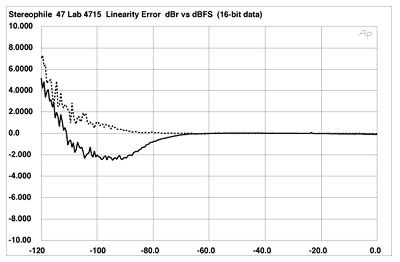I wrote a complete response to this in Mike's thread and it was this reply that was deleted and I was given a reply ban. So I say it is safe to say what I had to say was not to some people's liking.
I did not save the reply so here is another version.
The motivation for both running the linearity test and determining bit depths from it actually came from tests that Stereophile used to run. Here is an example:
https://www.stereophile.com/digitalprocessors/187/index.html
View attachment 10764
If I gave you this graph, and I asked you where there is too much error, you would probably draw a line a bit after the curve gets wiggly, say, around -110 dB. That is exactly what I am doing with my 0.1 dB variation from linearity.
While linearity is shown as a figure related to input value (X axis), it is very common to instead talk about it in the order of bits. See:
https://en.wikipedia.org/wiki/Differential_nonlinearity
And much more deeper treatment from the manufacturer of the DAC chip used in Schiit Yggy:
http://www.analog.com/media/en/trai...ndbooks/Data-Conversion-Handbook/Chapter5.pdf
View attachment 10766
LSB is least significant bit. The error can be 1, 2, 3 or more of LSB, reducing the effective resolution of the DAC by the same number of bits. So we are talking about bits in linearity measurements.
Here is a partial spec from Analog Devices on this front:
View attachment 10767
As you see they show 20 bits as the maximum resolution of the DAC, but then show under different conditions how much that is degraded in units of LSB (bits). In the example I have shown the error can be +- 1 dB or 2 dB total making the effective, error free resolution 18 bits. Worst case actually brings the resolution way down to 15 (-2.5 to + 2.5 bits). Don't run with these numbers as these are just the example from above. I am showing them just to demonstrate the common interpretation of linearity in the form of bits.
It is also true that we can also convert signal to noise ratio into bits. Here ENOB (effective number of bits) is a simple way to express something as is how it is used above. Here we are trying to determine how noisy the DAC is. In linearity we are trying to determine how distorted it is.
As to Schiit spec, this is all they say:
View attachment 10765
What don't know what frequency was used for this measurement. Or whether they used weighting which filters a lot of the noise making the number a lot higher. It is also possible this is measured with no signal, and then a full amplitude signal. A proper signal to ratio would be looking at the noise in presence of our full amplitude signal as the noise level can increase with signal. Without this kind of detail or a spectrum graph as I post, there is just no way of knowing what this number is.
SNR is such an important marketing number that manufacturers resort to every trick in the book to come up with the best number they can.
Summary
ENOB or effective number of bits can be applied to both distortion and noise measurements. My use of it with respect to linearity is absolutely consistent with how DACs are rated and measured. It is however not a common practice or term in audio reviews and hence lack of familiarity with it even from that Phd engineer.
Ultimately you can ignore my ENOB computation and just look at the graphs. The visual completely makes the same point when the DAC is compared to another showing much less error.
